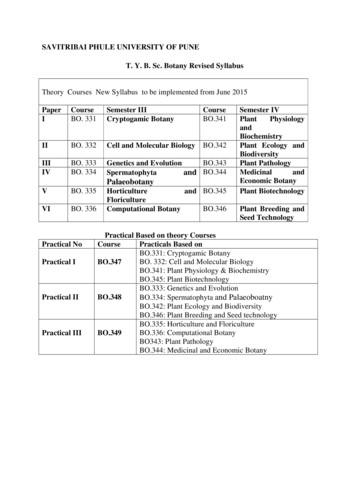Name: Per.: Date: Mass Extinctions On Earth Over Time
Name:Per.:Date:Mass Extinctions on Earth over TimeObjective: Identify the timing of mass extinctions and research their causes.Procedure: Use the data below to create line graph that illustrates the number offamilies (groups of related organisms) on Earth over the past 525 million years.DataMillions of years agoNumber of Families (Related groups of species)(x axis)(y 523521022038020524010055080600655300760
Name:Per.:Date:Mass Extinctions on Earth over TimeObjective: Identify the timing of mass extinctions and the causes of massextinctions.Part 1: Identifying Mass Extinctions on a GraphDirections: IDENTIFY and LABEL each mass extinction you see on yourgraph. Write the approximate time of each mass extinction on the graph whereit occurs. Write the name of each mass extinction on the graph (“PermianTriassic” for example). You will determine the names through yourresearch.Part 2: Internet ResearchBBC's NATURE: The Big 5 Extinctions: http://www.bbc.co.uk/nature/extinction eventsUse this article to research the possible causes of specific mass extinctions.BBC's NATURE: Mass Extinction Causes http://www.bbc.co.uk/nature/extinction causesUse this article to research HOW methane release, flood basalts, climate change, and impact events causeextinctions.Select ONE of the mass extinctions you identified to research. Yourresearch should include the following details:1. Name of extinction and when it happened2. What percentage of species went extinct (Overall, Marine, and/orTerrestrial).3. Identify the types of species that were most negatively affected.4. What was the cause or causes of each mass extinction? Providedetails on how these causes actually caused species to goextinct (Ex: How do flood basalts cause extinctions?) Summarize your research in paragraph form (Topic sentence,details, closing sentence). Summaries should incorporateresearched facts and details.
Part 3: Sixth Mass Extinction?Today many biologists think we are going through ANOTHER extinction eventthat HUMANS are causing. Research the possibility of a human-caused massextinction.Links:VideoPBS 6th Mass Extinction (9 min)https://www.youtube.com/watch?v z9gHuAwxwAsEgghead’s: Are We Facing a Sixth Mass Extinction? (3 mins)https://www.youtube.com/watch?v INWqAABweTgArticlesBBC’s: A Looming Mass Extinction Caused by ooming-mass-extinctionDiscovery News: World’s Sixth Mass Extinction May Be Under -events/mass-extinction-humans-animals110303.htmIn paragraph form address the following questions.1.How can humans be causing a possible mass extinction? What humanactivities are causing extinctions? Explain.2. What organisms are on the losing end of this hypothesized massextinction?3. Even if humans are not the cause of a mass extinction, do you thinkanother mass extinction is possible? Probable? Why or why not? Defendyour answer with reasons.Mass Extinction ActivityGraph Mass extinctions labeled with estimated timePoints5
and name.Research Paragraphs (2 Total) 1 on Historical Mass Extinction 1 on the current Sixth Mass Extinction Total30Paragraphs have topic sentence and have been proofread forgrammar and sense.Paragraphs have accurate facts.Paragraphs include all required details.Paragraphs incorporate explanations or summaries in your ownwords.35 points
1. How can humans be causing a possible mass extinction? What human activities are causing extinctions? Explain. 2. What organisms are on the losing end of this hypothesized mass extinction? 3. Even if humans are not the cause of a mass extinction, do you think another mass extinction is possible? Probable? Why or why not? Defend your answer .
2 POGIL Activities for AP . Mass Extinction 4 begins in _ and ends in _. Mass Extinction 5 begins in _ and ends in _. 7. What appears to be one criterion that scientists use when defi ning the timing of geologic periods? 8. Scientists name mass extinctions using the name of the time period during which the extinction .
as the 'sixth mass extinction'1,2. With three short words, we place the biotic and environmental disturbance created by mankind on par with the greatest biodiversity crises of the past half billion years. This is a comparison that demands close attention as the 'Big Five' mass extinctions
‘‘normal’’ extinction intensities, had little ef-fect on genus survivorship during the K/T ex-tinction and were unimportant in one or more of the other mass extinctions as well (Jablonski 1986a,b, 1989, 1995; Jablonski and Raup 1995; Smith and Jeffery 1998, 2000a; Lockwood 2003). (The fact that many of the neontological
Mass extinctions past and present: a unifying hypothesis. Biogeosciences Discus- . Origination and extinction of species have occurred throughout the history of life, with 20 the continual increase of diversity indicating the predominance of origination (Raup and . 15 Molecular analysis demonstrates that urease protein sequences are highly .
Nov 01, 2014 · Chaldean Catholic Church Mass Schedule SATURDAY VIGIL: 6:00pm Ramsha, Evening Prayer 6:30pm Mass in English SUNDAY MASS: 8:00am Sapra, Morning Prayer 8:30am Holy Mass in Chaldean 10:00am Holy Mass in Arabic 11:30am Holy Mass in English 1:15pm Holy Mass in Chaldean 7:30pm Holy Mass in English DAILY MASS: MONDAY THRU FRIDAY
At Your Name Name above All Names Your Name Namesake Blessed Be the Name I Will Change Your Name Hymns Something about That Name His Name Is Wonderful Precious Name He Knows My Name I Have Called You by Name Blessed Be the Name Glorify Thy Name All Hail the Power of Jesus’ Name Jesus Is the Sweetest Name I Know Take the Name of Jesus
guild. Second, real-world patterns of animal extinctions are generally nonrandom (28, 29) and may produce weaker or stronger effects on ecosystem processes than randomly ordered loss of species (24-27, 30). We evaluate declines in nutrient recycling predicted from the following known correlates of
Algae: (11L) 2. Algae: General characters, economic importance and Classification (Chapman and Chapman, 1973) up to classes. 03L . 3. Study of life cycle of algae with reference to taxonomic position, occurrence, thallus structure, and reproduction of Nostoc, Chara, Sargassum and Batrachospermum . 08 L.























